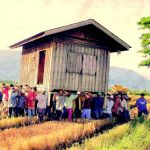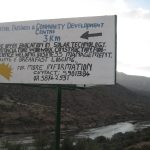
This gallery contains 1 photo.

This gallery contains 1 photo.

This gallery contains 1 photo.

This gallery contains 1 photo.

This gallery contains 1 photo.

This gallery contains 1 photo.

This gallery contains 1 photo.

This gallery contains 1 photo.
Public art is the medium which democratizes the process of manufacturing an urban landscape. Buildings are the city’s trees, and the mural is raw exposure to the ecology of the urban population. Nowhere else is the process of community design more inclusive. The murals in study were created by youth in two Boston low-income communities of color. By allowing this type of participation in the city, these youth can create places for themselves in a society that often tells them there is no place for them. Public art allows communities to reflect who they are. They exist as artifacts of cultural identity. Sometimes public art is forgotten, or even painted over. This is why public art so often lends itself to community participation. It is a medium that allows for changes in the community identity. We tend to enjoy murals and other forms of public art because they add character and evidence of who lives in the community. The author argues that public art is a form of community design participation that is implementable in all communities. Further, those communities that enact legislation (design standards) that prohibit this kind of public art aim to prohibit active participation in the community.
Often cities under the global spotlight use their landscape as a stage. The idea of a living performance is unique and at times problematic. We see this every other year with the winter and summer Olympics. Cities spend years working to prepare their city as all eyes will be on how well they can “perform”. In this article, author Anne Rademacher puts Kathmandu under a microscope. Soon after the state of Nepal declared a state of emergency, it had to host many South Asian countries for a major trade conference. Within days, many dilapidated housing complexes were leveled and new urban parks rapidly created. As with the Olympics, the long-term implications of the performance landscape after the performance has ended can often leave cities with inefficient and a landscape that is too-purpose built to be sustainable. This is not just a problem Kathmandu faces, but Kathmandu’s unique status as a place in need creates a unique problem. Globalization, in this instance, forced Kathmandu to compete with other global cities. In reality, the city is not on the scale of other global cities and normally, wouldn’t have to compete with the resource-privileged communities around the world. In fact, in a time when resources were strained, they had to be diverted away from crisis-alleviation and instead to meeting the demands of a global society.
In Palermo, Italy, the farmers’ market is the premiere social institution and exists as the intersection of the between political, economic, and environmental participation of its residents. The history of the market is carefully woven into the rich narrative of the community. Often the market has been a microcosm of events happening throughout the region. Changes in economic and social principles that occurred in the 20th century were girded by the fundamental principles of the market. Grassroots activism is central to Palermo’s culture. Civic participation is relatively high, as is the need to preserve the sustainable market that has existed in the city for centuries. Palermo benefits from being on a island (Sicily) and having access to a rich ecology leading to a diverse native diet. As Palermo’s residents discovered, the mobilization of consumers, while often intentionally degraded, represents a powerful force. These grassroots activists were able to preserve its integrity and very existence after it was threatened by an anti-institutional municipal government. For Palermo, the world may change, but the market will always exist as the beating heart of the community.
The growth of the Caribbean tourism industry has lead to a changing landscape. New urban centers are emerging as a new type of development. These urban centers are not dense with budding Caribbean populations but exist only as concentrated areas of tourism development. On any given day, the population of the area is made up of a high demographic of tourists, sometimes even more tourists than locals. This is true for many tourist centers around the world. These tourist centers emerge as demand increases for particular areas. The days of an area anchored by a single resort have passed. The creation of these resort towns which concentrate tourism into internationally-recognized places is causing a shift in the landscape. These are urban landscapes built not for growing populations but for growing tourism. Having an urban landscape dictated by an inherently transient population neglects the rich anthropology of the local people. These landscapes no longer reflect the culture of the place but rather, what the place is advertised to be. Author Amelia Moore argues that a greater incorporation of culturally- and naturally-dictated design and a respect for urban anthropology should be prioritized over the growth of the tourism industry. Failure to do so will deteriorate the sustainability of the region.
The metrics of sustainable living are highly contested among Swedes. This is the argument that ethnographer Cindy Isenhour argues in her piece, Imaginings and Practices of Sustainable Living in Sweden. The rift exists between those that subscribe to a quantitative metric of lifestyle evaluation and those that subscribe to a qualitative metric. Quantitative metrics are popular as they allow a technical understanding which is often more approachable and respected by the industrial and academic class which dominates urban society. Qualitative metrics allow for a sometimes unexplainable, almost inane connection to the natural landscape that cannot be measured or calculated. A popular belief exists in Stockholm and many western urban centers that urban living is more sustainable as, on paper, it has a smaller carbon footprint. This is based in the fact that often resources are more dense and well connected by multiple modes of transportation. This dense landscape results in a dense lifestyle. Rural Swedes argue that a sustainable lifestyle is one with a more direct connection to the natural landscape. Rural Swedish lifestyles are less dense but qualitatively more sustainable. However, there are several key principles that unite the quantitatively- and qualitatively-sustainable lifestyles. These are principles deep ingrained in Scandinavian culture. The idea of global equity and equal claim to the environment (land) are constitutional and inalienable rights. Both urban and rural dwellers have a merited claim to an open and healthy natural landscape.
Demaria et al.’s argument hinges itself on the concept of degrowth, an anti-utilitarian form of development. This concept has garnered quite the following as cities and nations around the world have begun to adopt the degrowth concept. Communities that adopt degrowth aim to retroactively eliminate inefficient development and return landscapes back to their natural aesthetic. Degrowth is seen as a more workable solution to those who feel that the world has grown too quickly and left too many behind. Those behind the degrowth thinking believe that a reduction in development will improve democracy, justice, and environmental conservation. However, growth is a reality that we are all facing as a human populous and failure to create the proper infrastructure for growth will not limit growth but rather reduce the quality of life in times of an exponentially increasing population. If degrowth is to continue, it must exist in the form of responsible growth that eliminates the impact of development. Degrowth should not be seen as a retaliation against all growth. Rather degrowth seeks to transform growth metrics away from quantity but rather into metrics of quality. Development which has many costs should not increase in size and shape like many of the urban areas of the last century, but should be seen as an evolution, increasing the quality of life for community members and the quality of the local landscape.
Martha Honey’s critical analysis of the ecotourism industry identifies a rift in the two forms of ecotourism. As she refers to them, there exists: sound ecotourism and ecotourism lite. This is another form of greenwashing, as is common across many industries. The goal of ecotourism, according to trade definitions, is transform tourist experiences beyond the traditionally wasteful leisure behaviors and use high-impact experiences to increasing conservation awareness. To do so, sound ecotourism experiences should take into account all of the aspects of tourism and not limit them to minor decisions that lack a concentrated effort. The discussion about ecotourism remains an unresolved dispute whose relevance remains poignant. Some countries are becoming mono-industrial, developing economies around a single industry, in this case eco-tourism, which can have dangerous effects economically. Environmentally however, these countries are more motivated to participate in conservation efforts because they have a bigger stake in the game. The degradation of their natural environment would result in declines in their ecotourism industries, limiting their growth and prosperity to that of the environment.
Libby Robin’s Australian perspective on the discipline of ecology reminds readers that the role of ecologists around the world varies. The perception of the discipline of ecology as a whole is seen as a “subset” of other natural sciences. Most ecologists are employed by the government, rather than research institutions or private corporations, like in the US. However like the US, the culture has come to rely on ecology only in times of despair, when it is easy, but has faced challenges accepting the findings of ecology when they go against other goals such as national development. When it came to Australia’s environmental movement, the common people generally supported bringing conservation scientists into the discussion to speak on their behalf against large development schemes or organizations. These scientists began to organize and voice uniform opinions based on homogenous consensus. The general population, after the successes of conservation scientists, accepted the role of scientists to speak on behalf of nature. This set up the modern discipline of applied ecology in Australia. However, the identity of ecologist, since it is created by the culture at-large, is subject to at-large interpretation. When the new green movement that sought to move away from hard science was lumped together with ecology, conservation scientists were forced to distinguish themselves. While both groups had the same goals, they differed in their intentions and if ecology was to remain the prominent voice in conservation, it had to stand by its scientific roots.
The disconnect between learned science and understood science is the subject of Checker’s piece. Learned science is owned by the camp of “experts” those with the universally accepted credentials to evaluate an environment. Understood science is owned by the community members that observe changes in their environment. The research method of learned science fixates on a particular observation and is pigeonholed into a specific area of study which limits the range of interpretation of phenomena. The research method of understood science is based in the observation of the entire environment, without identifying control or variables. One would argue that the camp of understood science would produce the better scientific understanding. However, the inability to translate observations into an analytical understanding that can be evaluated in a causal manner gives power to the learned science discipline. In the case of Checker’s research, residents of Hyde Park are in the understood science camp and EPA scientists are of the learned science. Because learned science has the power and is unable to reach the same conclusions as understood science, they believe there is no environmental problem. However, the observations of understood science are valid. The elimination of the disconnect between trained and citizen scientists or rather, increased collaboration and understanding between the two would lead to a more holistic understanding that would prevent the marginalization of communities that are not represented by the discipline of trained science.
Observation in the social sciences is based on a diverse library of perspectives. These perspectives are unique and separate but sometimes build off of one another. In an ideal world, the perfect social scientists would have an precise knowledge of all perspectives and be able to apply them unbiasedly across their research. Instead, social scientists often rely on a select few perspectives, often based on their own experiences. In the study of human-environment relations, there are a subset of perspectives. The association with gender and the environment is more broadly the culture/nature divide. Nightingale’s perspective on the differences in connections to the environment between genders are explained in a singular sense. This is done simply to introduce the idea to the reader. The author understands that in practice, a web of intersectionalities exist to create complex and unique circumstances. As social scientists, we should understand the same. The best social scientists are able to discern the perspectives and apply them precisely. By not putting too much weight on any single perspective yet also valuing the perspectives equally, you can recognize and piece together the puzzle that is each actor’s motivation. Gender and greater social and cultural institutions should not be an archetype to predict behavior but rather a motivator. Culture as an environment, in this case, dictates relationships between organisms. Gender is the defining characteristic of the human gender, and it is fluid, like climate, nature’s defining characteristic.
Edelman’s piece identifies international agriculturalists as an actor in the global environmental politics stage. With a lack of resources or formal recognition, government agencies have sprung up to speak on behalf of their livelihood. In the past few decades, these international agriculturalists, farmers that export surplus to other countries, have organized and mobilized to force themselves into the discussion. Sometimes this is accomplished by disrupting talks by agencies such as the WTO (formerly GATT) and other times they host their own talks to strengthen the bond of their community. The organization of these farmers, Via Campesina, is a heterogeneous organization made up of members from over 50 countries. This diversity does create some issues as naturally not everyone has the same goals. The organization recognized this early on and decided that instead of trying to homogenize ideology, they should focus on organizing and mobilizing so that the farmers in their position have a louder and more prominent voice in the discussion. This type of interaction represents a common pattern in citizen roles of environmental politics. Often citizens need to organize together to make a concentrated impact but goals and ideology are not always homogenous. The coalition model is more effective than the collective model because it allows for a rigid diversity that can withstand occasional differences in opinion but results in a net positive impact.
The debate of the control over natural resources is one that has caused a millenia of disputes. Bottled water creates an enigma for Wilk. Some have concern over the unsustainable nature of bottled water as a concept. Others have a concern over the safety of tap water, which incidentally enough, is often the source of bottled water. Communities that have made attempts to reject bottled water, such as the negative reaction to Dasani in the UK, end up stronger because of the dispute. While bottled water is still available in the UK, these communities are strengthened by their ability to organize and reject the corporate intrusion. The concept of “bottled air” was a concept that went viral several years ago. In countries like China where air pollution more days than not creates an uninhabitable atmosphere, bottled clean air is a popular product. While this may sound ridiculous to us, it is no more ridiculous than bottled water. Wilk’s poignant examination of the oddity that is bottled water represents a much larger issue. We have yet to settle who can lay proper claim to natural resources, especially water. Is it ethical for communities upstream to consume water at the cost of communities downstream? Is it ethical for landowners to allow the harvesting and exportation of natural resources if these activities result in environmental degradation in areas beyond the landowner’s holdings? These are the questions that Hardin predicted we would have to resolve. Bottled water is yet again another commons at risk.
Globalization has both direct and indirect effects. Sawyer’s examination of oil drilling in the Ecuadorian Amazon highlights how local groups intended to prevent multinational oil companies from polluting their environment. As time went on, the organization of local leaders formed a coalition of international groups aiming to end a pattern too frequently repeated around the world: multinational corporations taking advantage of vulnerable communities. After they realized they could not achieve their desired result through direct negotiation, they turned to more direct, political action. While the oil companies are still very present and powerful in Ecuador, this issue provided a catalyst for organization among the indigenous communities of Ecuador. Throughout much of the history of development, unintended consequences have occurred, at the cost of unachieved intentions. The idea of urban development began as a more efficient way to produce food as resources were pooled so community members could engage in other activities beyond hunting and gathering. The modern community model in place around the world creates a very uneven distribution of resources. As the community has become global, so has this phenomena. In the global community, there is an uneven distribution of wealth, power, and resources. One could argue that this could have been predicted as it is rooted in nature. In all ecosystems, the predator at the top of the food chain controls all of the wealth, power, and resources. The human community is modeled by the natural ecosystem. Those at the bottom of the food chain are rising up, in spite of this, to redistribute.
Taylor and Buttel agree that environmental issues should not be caught in the net of globalization. Doing so condemns these issues to the same sociological interpretations which do not lend itself to an accurate interpretation of scientific fact. This failure leads to discord surrounding around issues like climate change and natural resource control. Still, as the authors recognize, the interpretation of science has changed, as it should, but in a responsible fashion. As we are, for the first time, facing environmental issues that require complete cooperation among all people, this presents a challenge. Science therefore needs to transcend cultural differences and be universally understood, not only conceptually but a standard valuation of the facts. As we are seeing in many nations, the connection of environmental conservation to other issues has not been done so effectively. This results in a rejection of environmental net-positive actions. Taylor and Buttel’s arguement begs the question, who has the most power. With the Paris Climate Accord, every country has signed on except for the US and Syria. Can the combined force of almost every UN-recognized country force its will or is it subject to the will of the dissenters. More broadly, the authors suggest that the West could learn from the Third World’s mass consensus on climate change. This consensus is likely powered by a general animosity towards the West: the main culprits of climate change, and a realization that they will be disproportionately more affected by a changing climate. Cities, like New York City which has a population larger than many countries, are finding out that they carry their own weight and have emerged as actors on the global environmental politics stage.
Citizen science has emerged as a way to democratize scientific findings. Not all who make decisions that impact the environment come from a trained scientific background. If the scientific disciplines are to effectively convince policy makers and individual actors to adopt lifestyle changes, they must create a convincing narrative. The plight of scientists of the environment is similar to that plight of the indigenous. Indigenous peoples have always had to work on convincing the non-indigenous that they have a just claim to their existence and their protection. Since those making the policy do not share the same experience, they have to create an effective narrative to convince them to agree to their argument. Scientists, as the voice for the environment, possess the same challenge. In recent history, correlations between destructions of environments and indigenous communities revealed that environmentally destructive actions by non-indigenous communities result in simultaneous degradation of indigenous communities. Environmentalists have drawn further correlation, as Brosius notes, between environmental knowledge and the indigenous peoples due to their close-knit connection to their landscape. Environmentalists have discovered that they posses a unique environmental knowledge is difficult to describe in scientific terms. Scientists have been able to use this knowledge as the basis for effective conservation narratives. Environmentalists have capitalized on encouraging the low-footprint lifestyles of native peoples as a mechanism of sustainable living. The protection of human and natural communities must be directly correlated and presented to those with power in narratives that balance scientific and cultural knowledge in a socially-approachable manner.
The role your front lawn plays in the economy, society, and global environment is far underrated. This is the argument of authors Paul Robbins and Julie Sharp who argue that this monoculture undermines the dualisms of demand and supply, culture and economy, and regional and global. Counterinstitutionalization of the lawn by environmental groups attempts to disconnect the cultural value associated with a well-kept, green lawn as the economic and environmental resources required are now too great to justify. Culturally, this counterinstituionalization is working as people begin to understand that this type of monoculture is outdated and admittedly mundane. Municipal laws are seeing change across the continent as weeds are no longer seen as the enemy they once were. In Canada, the regression from lawn monoculture has been more dramatic than in the US. The movement began in a suburb of Montreal and reached its climax when it was brought before the Canadian Supreme Court. The court ruled that municipalities have the right to ban certain chemicals from its environment which it believes negatively harm their communities. People understand that having a manicured green lawn is not worth environmental degradation or the money, time, and resources required to invest in it. At the same time however, there are neighborhood groups that wish to enforce laws that establish lawn maintenance standards. These are in place to prevent properties from being the eyesore on the street. These laws however, when too strictly enforced, created this problem. There is a middle ground however, where a monoculture of a green, manicured lawn can be replaced with a diversity of native lawn types that can still be aesthetically pleasing, resource non-intensive, and environmentally friendly.
As authors Robert Todd Perdue and Gregory Pavela explain, the impact that natural resource extraction has on a community is much more closely related to time than originally thought. The case study in West Virginia highlights the extraction of coal as an example of a finite resource being exhausted and the impact that has on a community. While the short term benefits are abundant, they quickly dissipate and leave communities lacking in an sort of economic advantage. Tactics by some attempt to convince these rural communities that their prosperity is like urban environments (fluctuates in the short term but generally increases over the long run), and that the economic benefits will return. However, this is not the case as prosperity is directly correlated with economic opportunity. Once finite natural resources are extracted, the economic opportunity connected to them has been spent and, like the resource, will not replenish. These communities are even worse off because the extraction activities can pollute the environments so much that at a minimum quality of life is reduced but more commonly, public health is reduced as chronic illnesses and death increase. There is a clear pattern of predatory behavior by corporations and governments that exploits these vulnerable communities by exhausting their only economic advantage. These communities are often poor and lacking in alternatives so they accept this fate. Per the data highlighted in this article, market price of surface coal is correlated with per capita income and market cost is correlated with unemployment. This is an example of urban privilege. Cities have the benefit of enjoying a diversity of economic opportunities while rural areas are mono-dependent on a single opportunity. It is decisions and the demand of those in urban areas that destroys the economic mobility of rural.
Can our past failures at community development be traced back to something as elementary as having accurate definitions of urban rural, and suburban environments? While there are no universal quantitative parameters defining these descriptors, generally, they are used in terms of comparing population density relative to other spaces with different density. What we consider urban areas only exist because we are able to distinguish them from other areas that are noticeably less dense. The density difference is so noticeable that we believe the characteristics of daily life in these areas are different enough that we cannot call them urban areas, but rather rural areas. However, in the last few decades, we have seen a new human environment be created in the space between the urban and the rural in which elements of both environments are combined to form suburban environments that are not quite rural or urban yet are both rural and urban at the same time. This is a widely accepted understanding, but what if its wrong? After further study, anthropologists reveal that the characteristics that define these environments are much more diverse. Economic activity, social diversity, and access to natural resources all contribute to the establishment of urban, rural, and suburban environments. In fact, after reading this section, I would argue that proximity to resources and economic activity exist as two ends of a scale. Areas that have a close proximity to resources and economic activity are urban. Areas that have a close proximity to resources but less economic activity are rural. Areas that do not have a close proximity to resources but have relatively higher economic activity are suburban. Anthropologists and urbanists have to understand that these definitions are fluid with time and subject to change.
Disconnected attempts at development are prevalent throughout the landlocked African nation of Lesotho. Attempts to improve the commercial productivity of Lesotho’s natural resources have been unsuccessful. Authors James Ferguson and Larry Lohmann highlight specific examples of development projects that fail their intended goal, but instead lead to unintended side effects. In some cases, Lesotho benefits from these miscalculations. These projects can lead to more effective governments and increased infrastructure, the building blocks of sustainable development. Through decades of failed foreign intervention, Lesotho and its NGO (non-governmental organization) allies, are beginning to understand the that the question of, “What should we do?” is more complex that it appears. Each part of this question must be broken down and identified. Additionally, any attempt by stakeholders to expect a practical answer signifies that they fail to understand the complexity of the question. There is no specific project that can realistically and sustainably solve something as intricate as eliminating poverty in Lesotho. This goal cannot be met by even a single question. Instead, this question must be tailored to each specific situation. Efforts to address point opportunities of development will eventually lead to progress in the broader metrics. As an example, “What should we do?” becomes “Which resources could can and should the national government increase access to through foreign trade agreements?” Perhaps the most difficult answer for stakeholders to accept to these questions could be “Nothing”. Often those asking these types of questions have a narrow-minded approach to their answer. Many choose not to accept this answer because it would mean admitting that they asked the wrong question and do not yet fully understand the problem.
As urbanism evolves in the 21st century, the role of economic growth in sustainable development is being rebalanced. As Theodore Panayotou, author of Economic Growth and Empowerment, argues, in the past, efforts for economic growth were seen as the common sense catalyst for social development. As evident by the development patterns since the Era of Imperialism, economic growth often fails to take into account the unique factors of each society. This negligence often leads to the opposite of the intended impact. New thinking shows that for more effective development, the fundamentals of sustainability must be taken into account. Economic growth is still a manipulator of the development, but should be balanced with environmental conservation and social equitability. Panayotou highlights specific research that correlates economic growth with and unequal distribution of air pollution among certain income levels. This type of economic-focused development leads to an unhealthy income-environment relationship. Environmental degradation often correlates with efforts to increase economic growth. Recovery efforts to deal with pollution are costly and resource-intensive. However, they are still necessary. A better understanding of the impact of economic and social growth on the environment is, however slowly, leading to more sustainable development patterns. Cities in developing countries have opportunities that developed cities lack. Many see the modern development of urban areas in Southeast Asia and South America as opportunities. These urban areas are fortunate to learn from the mistakes of the past. These urban areas are likely to enjoy a future in which development allows for improvements in the resiliency of environments while seeing quality of life and economic opportunities grow steadily. This advantage will inevitably lead to a restructuring of urban areas around the globe as the sustainable city powerful city.
The 1984 Union Carbide gas leak left thousands in Bhopal, India dead and even more injured. The disaster was two-fold. The first wave of victims were those immediately killed or injured by the explosion. The second wave of victims were those left with chronic illnesses that have permanently reduce their quality of life. In both cases, a careless and distant corporate culture that prioritized profit over safety left one of India’s largest urban centers with a permanent social handicap. Further, the abandonment of any efforts to seek long-term solutions to this disaster has left a society paralyzed. Failures by the Union Carbide Company, a multinational corporation headquartered half a globe away from Bhopal, to make safety-conscious decisions and take actions contrary to the recommendations of local management officials is only one environmental disaster in a pattern that is all too common. The inability of the Indian state to adequately respond to disasters of this scale, early on in the recovery efforts, led to community-based attempts to organize and advocate. This ability of these groups to do so may be the only positive outcome from this lasting disaster. It is virtually impossible for even the wealthiest cities to prepare for an environmental disaster of this scale. However, the double standard becomes clear when studying the ability of wealthy cities to prevent such disasters. As the author, S. Ravi Rajan suggests, anthropologists, as community leaders and policy makers, are in a unique position to maneuver the public and private sectors to social development. By prioritizing proactive measures over reactive, and installing mechanisms to adequately hold those responsible accountable, the impacts to people and planet can be reduced or hopefully eliminated.
The Wari’ people are a indigenous Amazonian group with a complex understanding of our concepts of body, soul, and humanity. The Wari’ see these concepts as fluid, rather than stagnant. Additionally, these concepts are applied more broadly to living and non-living things rather than being restricted to humans or even living things. Aparecida Vilaça’s study of this rich culture makes an attempt to translate the Wari’ ideology in terms of our own understood constructs of body, soul, and humanity. These Chronically Unstable Bodies possess a possessive kwere which is used to describe the Wari’ concept of body. Much of the Wari’ understanding relates back to this concept of kwere. In fact, even reproduction is understood as reconstruction of the body rather than creation. Other concepts like humanity are seen as a condition, rather than an identity. Such a condition (wari’) is applied to a diversity of beings. This condition is based on geographic proximity, so all beings within proximity to the Wari’ are considered to be a member of the wari’ identity. In their understanding of what we would refer to as the soul, the jam is a source of instability within a being. Jam can be lost by being, such as spider monkeys, and beings seen as healthy and active are without jam. Vilaça recognizes that there is a rich culture in the Wari’ understanding of life and one’s self. This community is an example of a nature-dominated culture in which the Wari’ believe their central livelihood is dominated by these chronically unstable bodies.